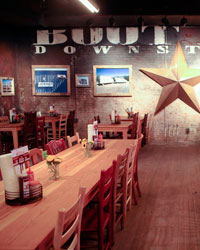
Probably the most similar to North Carolina, and that’s what drew me to it: They’re both all about the meat, though because of its long history of cattle ranching, Texas is traditionally beef. In the central part of Texas, the Hill Country, where Hill Country Barbecue originates, people use Post Oak wood because it grows indigenously there. They use a simple rub of salt, butcher-ground black pepper and just enough cayenne to turn the rub a light pink color.
They like to say, “We barbecue anything that moves.” They’re very partial to sauce, a very thick, red sauce. I think that the average American identifies with this barbecue region.
Memphis is known as the home of the dry rub, but they use a lot of sauce in Memphis, too. And Memphis pulled pork uses more of a sweet red sauce in their pulled pork, as opposed to the lighter tangy, peppery Carolina vinegar sauce.
North Carolina barbecue traditionally uses pork because of all the pig farms in the state. Hickory grows widely in North Carolina, so people tend to use hickory wood. In North Carolina the rub is just salt and pepper, no cayenne. Within North Carolina there are two subregions:
In Eastern North Carolina barbecue the sauce is vinegar-based, very peppery. And they don’t use ketchup.
In Western North Carolina barbecue they add a little ketchup, which turns the sauce red. I grew up in the Piedmont area, which is sort of halfway between the two, but by barbecue standards it’s considered Western, and we add ketchup to the vinegar sauce.
Then there’s the mustard region, a pocket in Georgia and a pocket in South Carolina. South Carolina is really the region that popularized the mustard, especially right around Columbia. And you know what? It’s not bad. The first time I tried it, I was skeptical, but if you think about it, they use yellow mustard, French’s mustard, that has a lot of vinegar in it anyway. So when I ate it, I was like, “OK! It’s just a yellow vinegar sauce!” But of course I still prefer what I grew up with.
Those are the major regions. But once you leave those, you’ve got St. Louis, where people are barbecue-crazy, and Alabama, which has a famous barbecue restaurant—Big Bob Gibson’s, where Chris Lilly is the pitmaster—that wins lots of awards. And then there are people in California who put their name on barbecue.
I gotta give a shoutout to my two Carolina boys. In Eastern North Carolina, Ed Mitchell is like the barbecue Santa Claus of the community. He uses a barrel smoker and smokes whole hogs, which not everybody does. Where I grew up, barbecue was a butt or a shoulder. But he does it the old-school way, which makes a big difference when he chops it all together. He’s got the ham, the shoulder, the tenderloin, a little bit of everything in there. You’ve got meat that’s a little bit leaner, a little bit moister, a little bit more tender, a little tougher—all of it together. He was at The Pit in Raleigh; now he left to open his own place. People can find him at the Big Apple Barbecue Block Party in New York.
Rodney Scott is from South Carolina, but he doesn’t do a mustard sauce because he’s not from that part of the state. He does a mop with vinegar and some other secret ingredients, and it’s very, very peppery. He butterflies the whole hog just like Ed does, but he cooks it on a really hot open fire. That’s not done by very many people, though I’m sure this is how it was done to celebrate the fall slaughter when everyone had land and livestock, including pigs. The great thing is, someone is honoring that tradition in a restaurant. TheScottsBBQ.com
Mike Mills is otherwise known as The Legend. His baby back ribs are legendary. He cooks each and every slab of ribs by feel. He is the barbecue grand master of “feeling the love.” His baby backs are just perfect. They’re kissed with smoke and have this beautiful hot pink smoke ring on them. They have just enough chew that you feel like you’re eating meat, yet they melt in the mouth into delicious pork heaven. 17thstreetbarbecue.com
They are the patron saints of Hill Country. We’re different, but they were our inspiration. I like that it’s all about the meat, it’s really simple, using Post Oak, and it’s just the way it’s been done for more than a hundred years; it’s now third-generation. They use an open fire box, and their smoker looks like a big brick coffin with a roaring fire on one side. The smoker is huge; it must be 40 feet of brick, steel, smoke and meat. And they have four of them. They also cook very, very hot. To create indirect heat, they move the meat from end-to-end of their pit with meat pins that are also more than 100 years old. It’s a sight to be seen. It’s so pure and unpretentious—it’s a great and true barbecue experience. KreuzMarket.com
If you like urban barbecue and you didn’t grow up in the South but you love well-smoked meat and tangy sweet sauce Dinosaur can’t be beat. They have tremendous respect for barbecue, even though they’re from upstate New York, which is not a “traditional” barbecue region. They do a great job of smoking their meat, and they add just enough sauce to keep it moist. They respect the meat. And I love that they say that barbecue saved their lives, because I think that the popularity of barbecue has played a role in saving American culinary traditions, particularly Southern culinary traditions. DinosaurBarbque.com
Find more of Elizabeth Karmel’s favorite stops along the barbecue trail on her website elizabethkarmel.com.

No comments:
Post a Comment